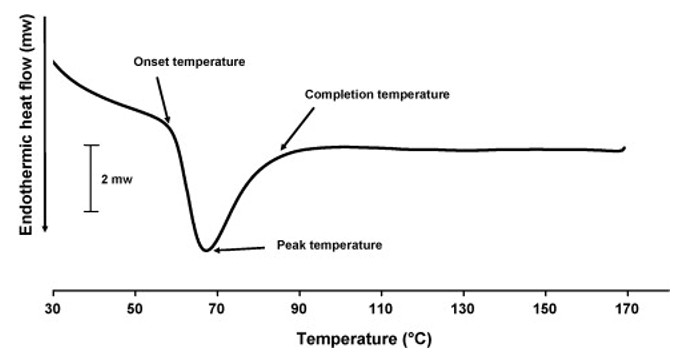Starch gelatinization is an endothermic process of the loss of starch crystallinity or the disruption of molecular orderliness within the starch granule under certain heat and moisture conditions. The diversity in gelatinization properties in starch can be attributed to various factors, such as the amylopectin structure, amylose content, the size and shape of granule, and the organization of these chemical components in the starch granules. To fully understand the phase transitions of starch granule is very important in food processing.
One of the most important parameters in the starch gelatinization study is the gelatinization temperature. Gelatinization temperature is one of the essential technical indexes of starch quality. Starch gelatinization usually commences at a range of temperatures dependent on the type of starch. The gelatinization temperature range is affected by changes within the environment of the starch granules - for example by reducing the amount of water available to the starch granules, or by adding high levels of hydrophilic molecules such as sugars, or even by the addition of simple salts.
In the process of starch gelatinization, to is defined as the initial gelatinization temperature or onset temperature, Tp1 is the begin of gelatinization or crystal melting also known as peak temperature, and Te is the final temperature or completion temperature. With the excess of water and the temperature increasing, starch granules can be molten cooperatively at Tp1. Gelatinization temperatures such as onset, peak, and completion temperature can be measured from differential scanning calorimetry (DSC) thermograms (shown in Figure 1).
 Figure 1. Example of the gelatinization of native potato starch by DSC.
Figure 1. Example of the gelatinization of native potato starch by DSC.
A number of analytical techniques have been used for the measurement starch gelatinization, such as DSC, viscometry, optical microscopy, electron microscopy, X-ray diffraction, fourier transform infrared (FTIR) spectroscopy, and nuclear magnetic resonance (NMR) spectroscopy. The thermal analytical techniques such as DSC can detect the heat flow changes associated with both the first-order and the second-order transitions of starch polymers. DSC is especially compatible to study the phase transition of starch–water systems because it allows the study of starch transitions over a wide range of moisture content, the determination of transition temperatures, and the enthalpy changes during phase transitions. Therefore, DSC has been widely used to study the starch gelatinization. By using DSC the phase transition of starch gelatinization can be observed and starch gelatinization temperature and enthalpy can be determined as it is manifest as an endothermic peak in the DSC thermogram.
As one of the leading companies in the omics field with over years of experience in omics study, Creative Proteomics provides glycomics analysis service customized to your needs. Contact us to discuss your project.
How to place an order:

*If your organization requires signing of a confidentiality agreement, please contact us by email.
References
- Qiang Liu, Elizabeth Donner, Richard Tarn, Jaspreet Singh, Hyun-Jung Chung (2009) Advances in Potato Chemistry and Technology, Chapter 8, P221-248.
- D F Coral et al (2009) Determination of the gelatinization temperature of starch presented in maize flours. J. Phys.: Conf. Ser. 167 012057.